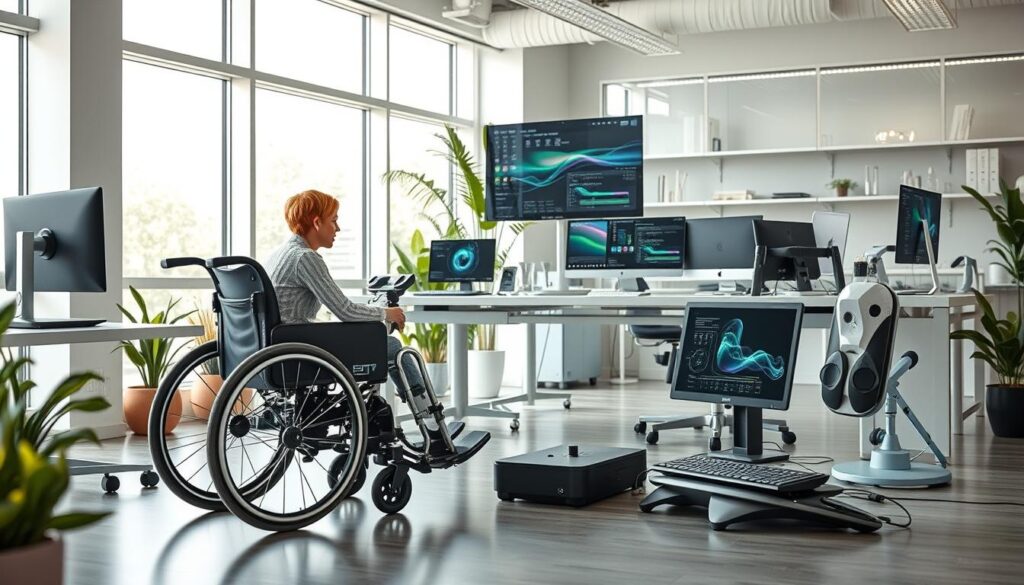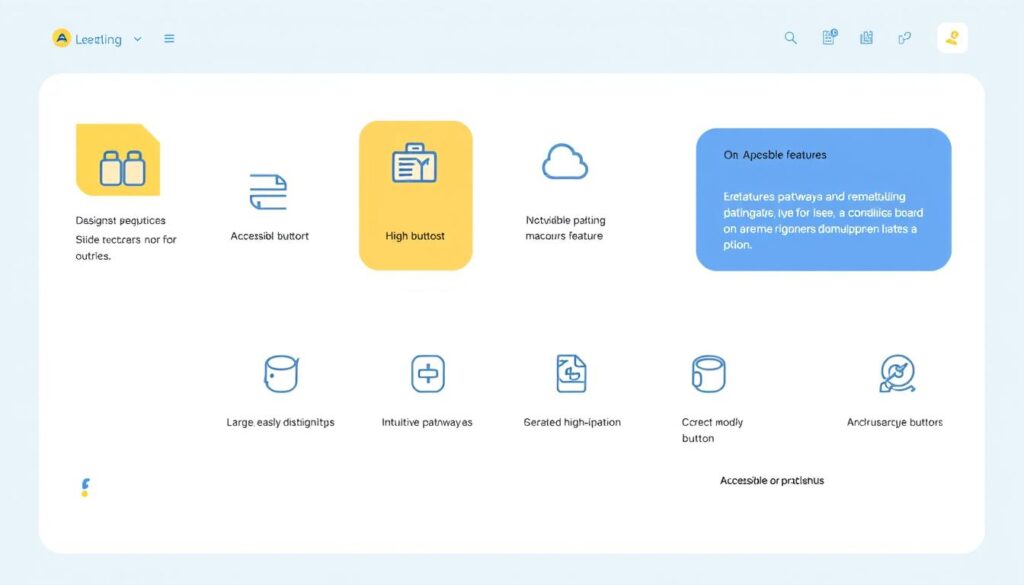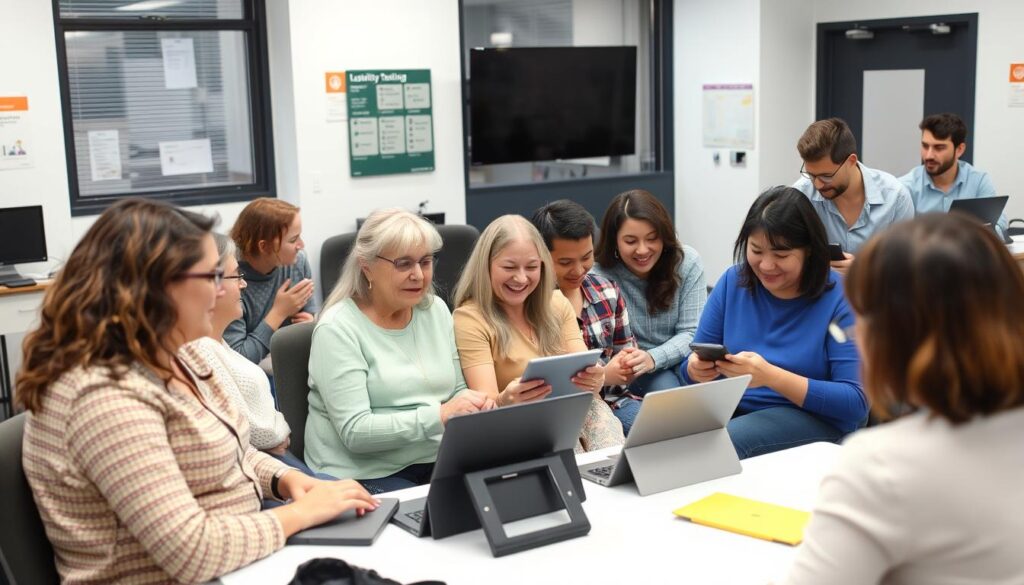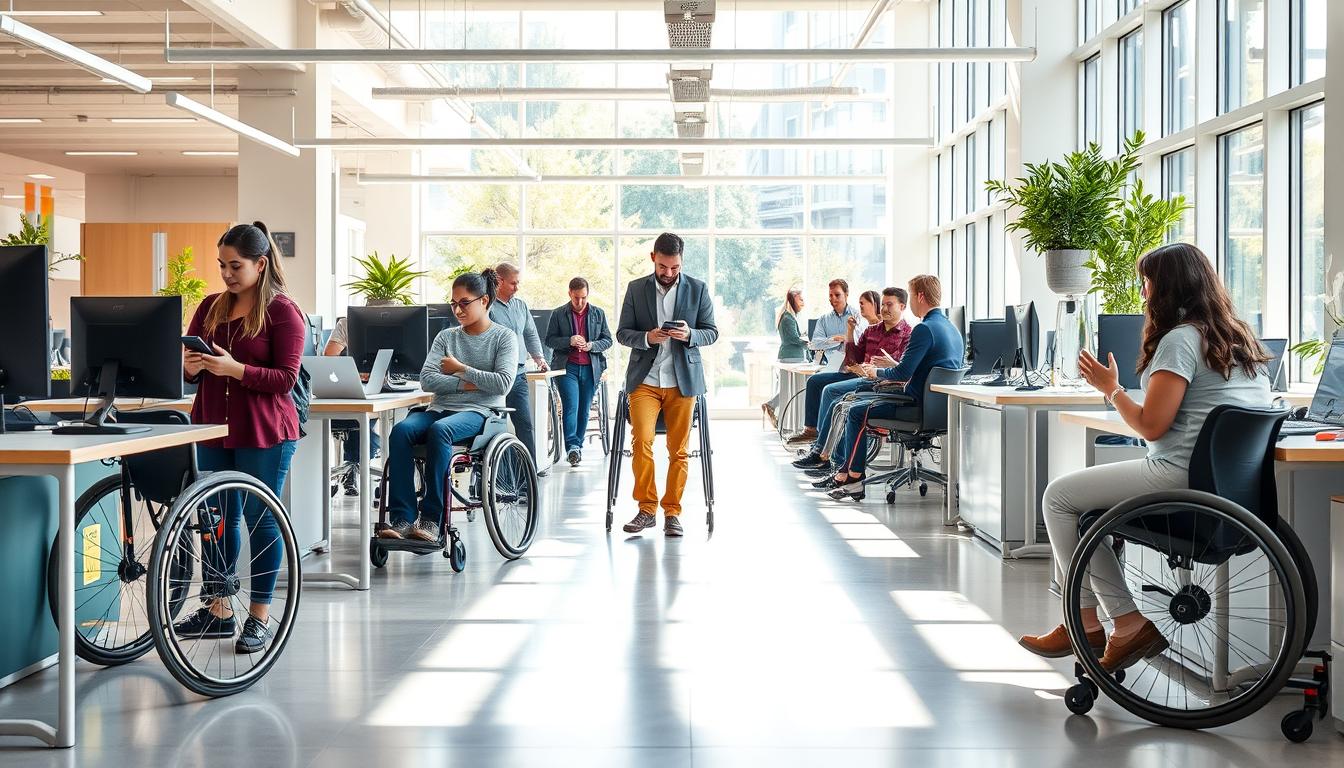In today’s world, making products and places for everyone is key. Accessibility and inclusive design are more than just words. They are the heart of good design, making sure everyone can use what we create.
By following Accessible Design, Inclusive Design, and Universal Design, we can remove barriers. This way, we give everyone a fair chance and make things better for all.
Design should fit everyone, not just one type. It should be flexible and meet the needs of all users. Learning about accessibility and inclusive design helps us make things that truly help and include everyone.
In this article, we’ll explore the basics of accessible and inclusive design. We’ll look at how accessibility standards have grown, the main ideas of universal design, and the real benefits of this approach. Let’s start a new way of designing, making things better for everyone.
Understanding the Foundations of Accessible Design, Inclusive Design
Accessible and inclusive design have a long history. They are based on evolving accessibility standards. Universal Design is a key concept. It aims to make environments and products usable by everyone, without needing special design.
The Evolution of Accessibility Standards
Accessibility Standards have grown a lot over the years. This growth came from a growing need for inclusive design. The Architectural Barriers Act in the 1960s and the Americans with Disabilities Act (ADA) in 1990 were big steps forward. They helped make spaces more accessible for people with different abilities.
Key Principles of Universal Design
The Universal Design philosophy has seven main principles. These are: equitable use, flexibility, simple use, clear information, tolerance for mistakes, low effort, and space for everyone. These principles help designers make things that everyone can use, making the world more inclusive.
Benefits of Inclusive Design Approach
Using an Inclusive Design approach brings many benefits. It makes things better for people with disabilities and for everyone else. It leads to solutions that are easy to use and meet many needs. Inclusive Design is a smart choice that makes things more accessible, improves customer happiness, and helps create a fairer society.
Breaking Down Barriers: The Impact of Design for All
Barrier-free Design and Disability Inclusion focus on making things accessible to everyone. This way, people with disabilities can fully join our society. It helps remove the barriers that have stopped them before.
Public spaces show how Barrier-free Design works. Curb cuts were first for wheelchair users. But now, they help many others too. This simple change has made moving around easier for many.
In the digital world, web accessibility is key. It makes websites and online content easy for all to use. Features like screen readers and keyboard navigation have opened new doors for many.
Design for All is changing our world for the better. It makes our society more fair and open. By removing barriers, we help everyone succeed, no matter their abilities. This effort benefits not just individuals but our communities too.
Essential Components of Human-centered Design
At the core of inclusive and accessible designs is human-centered design. This method puts the user first, helping us understand their needs and challenges. By focusing on user research and creating personas, we make designs that truly connect with people.
Empathy Mapping for Inclusive Solutions
Empathy mapping is a key part of human-centered design. It lets us see things from our users’ perspectives. By doing this, we gain insights that lead to designs that are easy to use and welcoming to all.
Iterative Testing Methods
We need to keep testing and improving our designs to meet everyone’s needs. Usability testing with real users shows us what works and what doesn’t. This ongoing process helps us make human-centered designs that are both accessible and enjoyable for everyone.
Implementing Assistive Technology in Modern Design
Creating inclusive designs is key, and assistive technology plays a big role. It helps people with disabilities do more in their daily lives. We need to make sure these technologies fit well in our designs.
Understanding Accessibility Standards is crucial. We follow guidelines like the Web Content Accessibility Guidelines (WCAG). This makes sure our digital products work for everyone. We focus on features like screen readers and captions.

We also think about physical Assistive Technology. This includes ergonomic controls and voice commands. Even haptic feedback can make things easier to use. By considering all user needs, we make products that help everyone succeed.
Color Theory and Contrast in Accessible Design
Accessible design is more than just functionality. It’s about making things look good and being inclusive. Color theory and contrast are key. Following WCAG color rules makes sure our designs are for everyone. Good typography and a clear visual order help with reading and using our designs.
WCAG Color Compliance Guidelines
The Web Content Accessibility Guidelines (WCAG) help us choose colors wisely. We need to think about how colors look together. This is important for people with color vision problems or low vision. Following these rules makes our designs look good and accessible to all.
Typography and Readability Standards
Typography is very important in *accessible design*. The right fonts, sizes, and weights make our content easy to read. We also need to think about spacing between lines and letters. This ensures our text is clear and easy to follow, no matter how well someone can see.
Visual Hierarchy Optimization
Designing for *usability* goes beyond just color and fonts. It’s also about organizing our designs well. By placing important elements in the right spots, we help users find what they need. This careful planning makes our designs easy to use and understand.
Navigation and Interface Accessibility Best Practices
Creating inclusive digital experiences starts with accessible navigation and user interfaces. We believe that usability and human-centered design are key. They help all users, no matter their abilities, to easily use our products and services.
Clear and intuitive navigation is essential. We organize content and functions in a logical way. This includes easy-to-find menus, breadcrumbs, and search options. We also make sure the interface is accessible with a keyboard, so users can move around without a mouse or touchscreen.

We also focus on making user interfaces clear and easy to read. We follow WCAG color compliance and accessible typography standards. This helps create interfaces that are clear, easy to read, and accessible for everyone.
Our commitment to making navigation and interfaces accessible shows our dedication. We aim to empower all users and provide digital experiences that meet everyone’s needs.
Creating Barrier-free Digital Experiences
We aim to make digital experiences for everyone. This means thinking about different devices and platforms. Making sure everyone can use our digital stuff is key.
Mobile Accessibility Considerations
More people use mobile devices every day. We need to make sure our designs work well on these. This includes easy-to-use touch screens, clear text on small screens, and features like voice control.
Cross-platform Compatibility
We want our digital stuff to work on all kinds of devices. This means it should work on desktops, tablets, and phones. By doing this, we meet the needs of many users.
Responsive Design Techniques
Responsive design is essential for inclusive digital experiences. It makes sure our designs fit any device or screen size. This way, our designs are easy to use on any platform.
Usability Testing for Inclusive Design
Creating accessible and inclusive designs starts with usability testing. We test how different people use our designs. This helps us make sure everyone can use them, no matter their abilities.
Usability testing is more than just seeing if people can do tasks. It checks if our designs are easy to use and understand. We look for ways to help people with different needs use our products better.

We use iterative testing methods and assistive technologies to improve our designs. By listening to users with different needs, we make our products better for everyone. This makes our designs more usable and inclusive.
Our dedication to usability testing shows our commitment to helping everyone. It’s a journey of learning and getting better. It benefits both our users and our company.
Legal Requirements and Compliance Standards
Exploring Accessibility Standards and Disability Inclusion is key. We must grasp the legal rules that guide these areas. Here, we’ll look at the main guidelines and tools for designers and companies to make inclusive experiences.
ADA Guidelines
The Americans with Disabilities Act (ADA) outlines detailed rules for digital accessibility. It covers many aspects, like color contrast and text readability. Following ADA rules is vital for making digital products accessible and inclusive.
International Accessibility Standards
There are also international accessibility standards to consider. The Web Content Accessibility Guidelines (WCAG) and EN 301 549 are examples. These standards help create accessible digital experiences for users worldwide.
Compliance Testing Tools
There are many tools to check if your designs meet Accessibility Standards. These tools help find and fix issues related to Disability Inclusion. This way, you can make experiences accessible to everyone.
Knowing the legal rules and using the right tools helps designers and companies. They can then create digital experiences that are inclusive and empowering for all.
Conclusion
Accessible Design and Inclusive Design are key to a fairer world. They help us make digital and physical spaces better for everyone. By focusing on different abilities, we create products and places that everyone can enjoy.
We’ve learned a lot about making things accessible. This includes following accessibility standards and using assistive technologies. We also see how important usability testing is. These steps help us make sure everyone can use what we create.
Accessible Design and Inclusive Design are more than just rules. They show our commitment to fairness and inclusion. As we innovate, let’s always remember to put people first. This way, we make sure everyone has a great experience in the digital and physical world.



